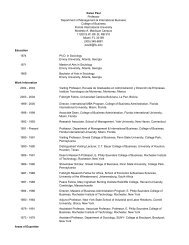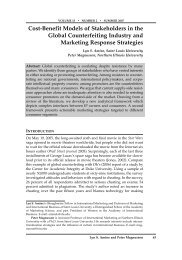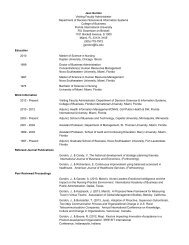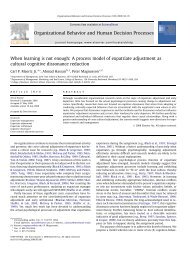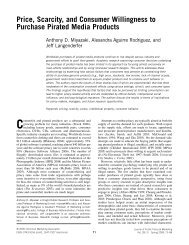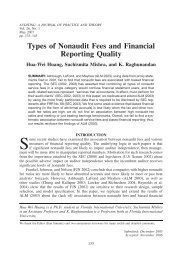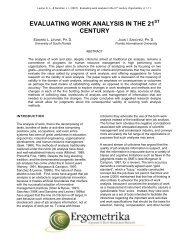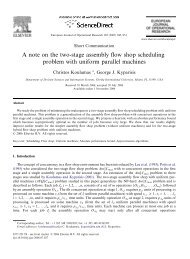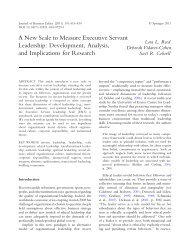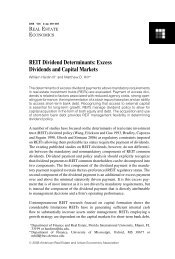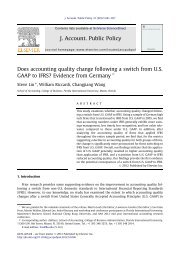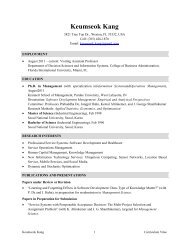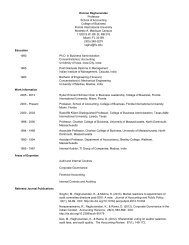Improving timeliness and efficiency in the referral process for safety ...
Improving timeliness and efficiency in the referral process for safety ...
Improving timeliness and efficiency in the referral process for safety ...
Create successful ePaper yourself
Turn your PDF publications into a flip-book with our unique Google optimized e-Paper software.
J Ambulatory Care ManageVol. 33, No. 2, pp. 124–130Copyright c○ 2010 Wolters Kluwer Health | Lipp<strong>in</strong>cott Williams & Wilk<strong>in</strong>s<strong>Improv<strong>in</strong>g</strong> Timel<strong>in</strong>ess<strong>and</strong> Efficiency <strong>in</strong> <strong>the</strong>Referral Process <strong>for</strong> SafetyNet ProvidersApplication of <strong>the</strong> Lean Six SigmaMethodologyGloria J. Deckard, PhD; Nancy Borkowski, DBA;Deisell Diaz, PhD; Carlos Sanchez, MBA;Serge A. Boisette, MHSAAbstract: Designated primary care cl<strong>in</strong>ics largely serve low-<strong>in</strong>come <strong>and</strong> un<strong>in</strong>sured patients whopresent a disproportionate number of chronic illnesses <strong>and</strong> face great difficulty <strong>in</strong> obta<strong>in</strong><strong>in</strong>g <strong>the</strong>medical care <strong>the</strong>y need, particularly <strong>the</strong> access to specialty physicians. With limited capacity <strong>for</strong>provid<strong>in</strong>g specialty care, <strong>the</strong>se primary care cl<strong>in</strong>ics generally refer patients to <strong>safety</strong> net hospitals’specialty ambulatory care cl<strong>in</strong>ics. A large public <strong>safety</strong> net health system successfully improved <strong>the</strong>effectiveness <strong>and</strong> <strong>efficiency</strong> of <strong>the</strong> specialty cl<strong>in</strong>ic <strong>referral</strong> <strong>process</strong> through application of Lean SixSigma, an advanced <strong>process</strong>-improvement methodology <strong>and</strong> set of tools driven by statistics <strong>and</strong>eng<strong>in</strong>eer<strong>in</strong>g concepts.Key words: access, ambulatory care, <strong>process</strong> improvement, Six Sigma,specialty <strong>referral</strong>Author Affiliations: Decision Sciences <strong>and</strong>In<strong>for</strong>mation Systems, College of Bus<strong>in</strong>essAdm<strong>in</strong>istration, Florida International University,Miami (Dr Deckard); Health Care ManagementPrograms, College of Bus<strong>in</strong>ess Adm<strong>in</strong>istration,Florida International University (Dr Borkowski); SixSigma Master Black Belt, Dev<strong>in</strong> Consult<strong>in</strong>g Group,Miami, Florida (Dr Diaz) <strong>and</strong> Six Sigma Black Belt,Deiv<strong>in</strong> Consult<strong>in</strong>g Group, Miami, Florida (MrSanchez); <strong>and</strong> Six Sigma Green Belt, AmbulatoryManaged Care & Quality, Jackson Health System,Miami,Florida (Mr Boisette).The authors thank <strong>the</strong> members of <strong>the</strong> Six Sigmateam from Jackson Health System, Miami, Florida:Dr Yolangel Hern<strong>and</strong>ez-Suarez, Associate Chief MedicalOfficer; Dr Angela Burrafato, Medical Director,Ambulatory Care Center; Dr Thresia Gambon, MedicalDirector, Primary Care Centers; Dr Lenworth Angl<strong>in</strong>,Medical Director, Quality <strong>and</strong> Managed Care; Mary-Keen Rob<strong>in</strong>son, ARNP, Quality Manager, AmbulatoryServices Division; Ester Eisler, Director, Ambulatory Services;Ela<strong>in</strong>e Perdue, RN, Associate Director of PatientCare Services; Kev<strong>in</strong> Lynch, Director of Applications <strong>and</strong>In<strong>for</strong>mation Technology; Dr Suzanne M<strong>in</strong>or, PrimaryCare Physician; Marta Garcia, RN, Cl<strong>in</strong>ical Care Coord<strong>in</strong>ator,Referral Services; Conchita Freitag, RN, Cl<strong>in</strong>icalEducator; <strong>and</strong> Debbie Turbert, RN, Director of PatientCare Services, Ambulatory Care Center.124ESTIMATES SUGGEST that communityhealth centers (CHCs) <strong>and</strong> designatedlow <strong>in</strong>come primary care cl<strong>in</strong>ics (PCCs) servemore than 18 million <strong>in</strong>dividuals annually(National Association of Community HealthCenters [NACHC], 2009a). These <strong>safety</strong> netproviders largely serve low-<strong>in</strong>come membersof racial <strong>and</strong> ethnic m<strong>in</strong>orities, who are un<strong>in</strong>suredor publicly <strong>in</strong>sured; present a disproportionatenumber of chronic illnesses (NACHC,2009a,b; Robert Wood Johnson Foundation,2005); <strong>and</strong> face great difficulty <strong>in</strong> obta<strong>in</strong><strong>in</strong>g<strong>the</strong> medical care <strong>the</strong>y need, particularly accessto specialty physicians. Although PCCs<strong>and</strong> CHCs serve as <strong>the</strong> medical home, <strong>the</strong>secenters have limited capacity <strong>for</strong> provid<strong>in</strong>gCorrespond<strong>in</strong>g Author: Gloria J. Deckard, PhD, DecisionSciences <strong>and</strong> In<strong>for</strong>mation Systems, College of Bus<strong>in</strong>ess,Florida International University, 11200 SW 8th St,Miami, FL 33199 (deckardg@fiu.edu).
<strong>Improv<strong>in</strong>g</strong> Timel<strong>in</strong>ess <strong>and</strong> Efficiency <strong>in</strong> <strong>the</strong> Referral Process <strong>for</strong> Safety Net Providers 125specialty care <strong>and</strong> face difficulties <strong>in</strong> <strong>referral</strong>sas fewer private physicians, academic medicalcenters, <strong>and</strong> community hospitals are will<strong>in</strong>gto provide specialty care to <strong>the</strong> un<strong>in</strong>sured(Felt-Lisk et al., 2002). Safety net hospitalsthrough specialty ambulatory care cl<strong>in</strong>icshave become <strong>the</strong> providers of last resort <strong>for</strong>specialty care services <strong>for</strong> <strong>the</strong> <strong>in</strong>creas<strong>in</strong>g numberof un<strong>in</strong>sured <strong>and</strong> o<strong>the</strong>r vulnerable populations.Evidence suggests ever-leng<strong>the</strong>n<strong>in</strong>gwait times <strong>for</strong> <strong>the</strong> un<strong>in</strong>sured, especially adultswith chronic illnesses, to obta<strong>in</strong> specialty careappo<strong>in</strong>tments, with <strong>the</strong> first available appo<strong>in</strong>tmentbe<strong>in</strong>g <strong>in</strong> 6 months to a year (Felt-Lisket al., 2002). In addition, healthcare <strong>process</strong>es(eg, <strong>referral</strong> systems) created <strong>and</strong>/or changedon an ad hoc basis over time may becomeunnecessarily complex (Kaplan et al., 2009).Referral <strong>process</strong>es that are unstructured <strong>and</strong>complex create <strong>in</strong>efficiencies <strong>in</strong> <strong>the</strong> system<strong>and</strong> delay <strong>the</strong> provision of specialty care.Unnecessary complexities <strong>in</strong> <strong>the</strong> <strong>referral</strong><strong>process</strong> exacerbate delays <strong>in</strong> <strong>the</strong> receipt of services<strong>and</strong> impact patient quality of care. TheInstitute of Medic<strong>in</strong>e (IOM, 2001) suggeststhat overly complex delivery <strong>process</strong>es thatrequire numerous steps <strong>and</strong> patient “h<strong>and</strong>offs”slow down care, decrease <strong>safety</strong>, <strong>and</strong>waste resources. Cross<strong>in</strong>g <strong>the</strong> Quality Chasm(IOM, 2001) identified <strong>timel<strong>in</strong>ess</strong>—reduc<strong>in</strong>gwaits <strong>and</strong> sometimes harmful delays—<strong>for</strong>both those who receive <strong>and</strong> those who givecare <strong>and</strong> <strong>efficiency</strong>—avoid<strong>in</strong>g waste, <strong>in</strong>clud<strong>in</strong>gwaste of equipment, supplies, ideas, <strong>and</strong>energy—as aims or goals <strong>for</strong> improvement of<strong>the</strong> US healthcare system. Provid<strong>in</strong>g timely<strong>and</strong> appropriate care to <strong>the</strong> un<strong>in</strong>sured <strong>and</strong>o<strong>the</strong>r vulnerable populations is a national concernthat can be addressed, at least <strong>in</strong> part, byimprov<strong>in</strong>g <strong>the</strong> PCC/CHC to specialty <strong>referral</strong><strong>process</strong> through per<strong>for</strong>mance-improvementstrategies such as Lean Six Sigma.PROCESS IMPROVEMENT BY USINGLEAN SIX SIGMAProcess improvement is <strong>the</strong> act of analyz<strong>in</strong>ga <strong>process</strong> (macro or micro) to determ<strong>in</strong>e howit can be done better <strong>and</strong> proceed to make<strong>the</strong> necessary changes to improve outcomes(Diaz, 2008). There are 2 paths to <strong>process</strong>improvement: unstructured <strong>and</strong> structured.Unstructured <strong>process</strong> improvement does notprovide an organized method <strong>and</strong>, thus, canresult <strong>in</strong> ad hoc changes. Lack<strong>in</strong>g a st<strong>and</strong>ardmethodology, improvement relies on <strong>in</strong>dividualexpertise ra<strong>the</strong>r than on measures ormetrics to guide <strong>the</strong> <strong>process</strong> <strong>and</strong> set goals.Structured <strong>process</strong> improvement, on <strong>the</strong>o<strong>the</strong>r h<strong>and</strong>, provides a st<strong>and</strong>ard, organizedmethod to guide improvements <strong>for</strong> changethat is based on measures <strong>and</strong> responsibilities.Kaplan et al. (2009) note that <strong>in</strong>tentionallydesigned (structured) <strong>process</strong>-improvementstrategies are more likely to yield efficient <strong>and</strong>effective <strong>process</strong>es.Six Sigma is a tested <strong>and</strong> commonly knownstructured method that utilizes comprehensivedata-driven tools supported by statisticalanalysis to improve <strong>process</strong> per<strong>for</strong>mance(Diaz, 2008). The Six Sigma method<strong>in</strong>cludes 5 phases: def<strong>in</strong>e-measure-analyzeimprove-control,commonly referred to as <strong>the</strong>DMAIC technique. These phases are used toimprove exist<strong>in</strong>g <strong>process</strong>es to improve overallper<strong>for</strong>mance. The DMAIC methodology has aproven data drill-down capability that is basedon statistical analysis. This helps achieve <strong>the</strong>goal with<strong>in</strong> Six Sigma: reduce variation.Lean provides a set of transitional tools thatidentify valuable <strong>and</strong> <strong>in</strong>valuable activities wi<strong>the</strong>vents or activities (steps). The Lean analysisp<strong>in</strong>po<strong>in</strong>ts specific improvements by elim<strong>in</strong>at<strong>in</strong>gsteps that <strong>in</strong>cur costs but are not valuableto <strong>the</strong> desired end result. Lean <strong>and</strong> SixSigma comb<strong>in</strong>ed dramatically reduce variation,unpredictability, <strong>and</strong> potential negativeoutcomes while m<strong>in</strong>imiz<strong>in</strong>g costs.Six Sigma was orig<strong>in</strong>ally developed byMotorola as a quality improvement methodology,<strong>and</strong> its use was exp<strong>and</strong>ed by o<strong>the</strong>rcompanies such as General Electric <strong>and</strong> AlliedSignal/Honeywell (Black & Revere, 2006).A review of Six Sigma applications acrossa variety of healthcare <strong>process</strong>es (Vest &Gamm, 2009) demonstrates <strong>the</strong> effectivenessof Six Sigma methodology <strong>for</strong> healthcare organizations.The array of <strong>process</strong>es exam<strong>in</strong>edby Vest <strong>and</strong> Gamm (2009) <strong>in</strong>cludedsurgery turnaround time, cl<strong>in</strong>ic appo<strong>in</strong>tment
126 JOURNAL OF AMBULATORY CARE MANAGEMENT/APRIL–JUNE 2010access, h<strong>and</strong> hygiene, antibiotic prophylaxis<strong>in</strong> surgery, schedul<strong>in</strong>g radiology procedures,<strong>and</strong> meet<strong>in</strong>g Centers <strong>for</strong> Medicare <strong>and</strong> MedicaidServices cardiac <strong>in</strong>dicators. Earlier workby Gamm et al., (2007) suggested <strong>the</strong> usefulnessof Six Sigma <strong>in</strong> address<strong>in</strong>g <strong>the</strong> IOM“quality chasm.” Lean Six Sigma provides astructured, systematic approach to improv<strong>in</strong>ghealthcare <strong>process</strong>es <strong>and</strong> meet<strong>in</strong>g <strong>the</strong> challengesof quality improvement.APPLICATION OF LEAN SIX SIGMA ANDDMAIC TO A SPECIALTY REFERRALPROCESSRecogniz<strong>in</strong>g <strong>the</strong> value of both Lean <strong>and</strong> SixSigma approaches, <strong>the</strong> Jackson Health System(JHS) <strong>in</strong> Miami-Dade County, Florida, soughtto improve <strong>the</strong> effectiveness <strong>and</strong> <strong>efficiency</strong> of<strong>referral</strong>s <strong>for</strong> specialty care through applicationof Lean Six Sigma methodology. Two specialtycl<strong>in</strong>ics were identified to participate <strong>in</strong> <strong>the</strong>project: (1) genitour<strong>in</strong>ary (GU) <strong>and</strong> (2) gynecology(GYN). A multidiscipl<strong>in</strong>ary team wasidentified <strong>and</strong>, with <strong>the</strong> assistance of 2 SigmaBlack Belt mentors, <strong>the</strong> project followed <strong>the</strong>DMAIC approach (Diaz, 2008):DEFINE <strong>the</strong> project’s purpose <strong>and</strong> scope<strong>and</strong> obta<strong>in</strong> background on <strong>the</strong> current <strong>process</strong><strong>and</strong> <strong>the</strong> customers’ perspectives;MEASURE data that p<strong>in</strong>po<strong>in</strong>t problem locationor occurrence; focus <strong>the</strong> improvement ef<strong>for</strong>tby ga<strong>the</strong>r<strong>in</strong>g basel<strong>in</strong>e <strong>in</strong><strong>for</strong>mation on <strong>the</strong>current situation;ANALYZE data to identify <strong>and</strong> confirm rootcauses; set goals <strong>for</strong> per<strong>for</strong>mance;IMPROVE <strong>process</strong> by implement<strong>in</strong>gplanned solutions; elim<strong>in</strong>ate or reduce <strong>the</strong>impact of <strong>the</strong> identified root causes; <strong>and</strong>CONTROL <strong>the</strong> ga<strong>in</strong>s by st<strong>and</strong>ardiz<strong>in</strong>g <strong>process</strong>es;use data to evaluate <strong>the</strong> solutions; anticipatenext steps.Def<strong>in</strong>eOver time, <strong>the</strong> <strong>process</strong> of specialty <strong>referral</strong>from primary care physicians (PCPs) at PCCs<strong>and</strong> CHCs to <strong>the</strong> JHS ambulatory care specialtycl<strong>in</strong>ics (ACSC) had grown cumbersome<strong>and</strong> fragmented impact<strong>in</strong>g <strong>the</strong> <strong>efficiency</strong> of<strong>the</strong> <strong>process</strong>. In addition, <strong>the</strong> effectiveness of<strong>the</strong> system varied. A Pareto chart (ie, a type ofbar chart that aligns categorical data) was constructedto graph <strong>the</strong> problems across referr<strong>in</strong>gentities. This analysis demonstrated thatPCCs’ consult requests took twice as long aso<strong>the</strong>r services <strong>and</strong> that PCCs were less successfulat convert<strong>in</strong>g consult requests to specialtyappo<strong>in</strong>tments than were o<strong>the</strong>r services.Thus, <strong>the</strong> PCCs were identified as <strong>the</strong> focus<strong>for</strong> <strong>the</strong> <strong>in</strong>itial project.A fishbone diagram (Fig 1) was developedto obta<strong>in</strong> background <strong>and</strong> underst<strong>and</strong> <strong>the</strong>current <strong>referral</strong> <strong>process</strong> <strong>for</strong> PCCs. Review<strong>in</strong>gthis diagram, <strong>the</strong> team discovered <strong>in</strong>efficiencies<strong>and</strong> developed <strong>the</strong> follow<strong>in</strong>g problem description:“The <strong>referral</strong> <strong>process</strong> from PCP to<strong>the</strong> Patient Cl<strong>in</strong>ical Care Coord<strong>in</strong>ator (PCCC)<strong>for</strong> review is not efficient <strong>and</strong> <strong>the</strong> time lagbetween Appo<strong>in</strong>tment Made to Day of Appo<strong>in</strong>tmentis excessive.” The objective of <strong>the</strong>project <strong>the</strong>n became restructur<strong>in</strong>g <strong>the</strong> system<strong>for</strong> consults to improve quality <strong>and</strong> <strong>timel<strong>in</strong>ess</strong>of communication between primary carephysicians, primary care coord<strong>in</strong>at<strong>in</strong>g center,<strong>and</strong> specialty physicians. Specifically, <strong>the</strong> aim<strong>for</strong> improvement was to reduce turnaroundtime.The next step <strong>in</strong> <strong>the</strong> <strong>process</strong> was to diagrama <strong>process</strong> map detail<strong>in</strong>g <strong>the</strong> steps <strong>in</strong> <strong>the</strong><strong>process</strong> from <strong>the</strong> PCP determ<strong>in</strong><strong>in</strong>g <strong>the</strong> need<strong>for</strong> a <strong>referral</strong>/consultation through <strong>the</strong> consult<strong>process</strong> (review, approval, <strong>and</strong> service)<strong>and</strong> <strong>the</strong> returned <strong>referral</strong>/consult to <strong>the</strong> PCP.This <strong>process</strong> map followed a st<strong>and</strong>ard SIPOC(supplier, <strong>in</strong>puts, <strong>process</strong>, outputs, <strong>and</strong> customers)analysis <strong>and</strong> provided <strong>the</strong> tools toidentify appropriate measures <strong>and</strong> steps ofvalue/nonvalue activities.MeasuresData were collected to p<strong>in</strong>po<strong>in</strong>t <strong>the</strong> problems<strong>and</strong> focus <strong>the</strong> improvement ef<strong>for</strong>t. At thisphase, <strong>the</strong> Critical to Quality (CTQ) was identifiedas “turnaround time <strong>for</strong> consult” (<strong>referral</strong>).CTQs are core customer-focused requirementsthat provide a measure to determ<strong>in</strong>ewhe<strong>the</strong>r <strong>the</strong> objectives are be<strong>in</strong>g met, thatis, <strong>the</strong> <strong>referral</strong>s are <strong>process</strong>ed <strong>and</strong> appo<strong>in</strong>tmentsare made <strong>in</strong> a timely fashion. Timelyfashion was <strong>the</strong>n quantified; specifically, if <strong>the</strong>
<strong>Improv<strong>in</strong>g</strong> Timel<strong>in</strong>ess <strong>and</strong> Efficiency <strong>in</strong> <strong>the</strong> Referral Process <strong>for</strong> Safety Net Providers 127Figure 1. Fishbone diagram outl<strong>in</strong><strong>in</strong>g background of specialty <strong>referral</strong> <strong>process</strong>. PCP <strong>in</strong>dicates primarycare physician.<strong>process</strong> takes more than 30 days (4 weeks), itdoes not meet <strong>the</strong> criteria.AnalyzeThe analysis phase utilized several stepsto identify <strong>and</strong> confirm root causes of <strong>in</strong><strong>efficiency</strong>(ie, delays <strong>in</strong> mak<strong>in</strong>g appo<strong>in</strong>tments) toaddress <strong>process</strong> improvement. All paper <strong>referral</strong>s<strong>for</strong> GU <strong>and</strong> GYN were collected <strong>and</strong>reviewed; all approved appo<strong>in</strong>tments <strong>for</strong> GU<strong>and</strong> GYN were collected <strong>and</strong> reviewed; <strong>and</strong>pathways were identified <strong>and</strong> analyzed. Theoutcomes <strong>for</strong> all <strong>referral</strong>s (ie, <strong>in</strong>complete, <strong>in</strong>appropriate,approved) were documented <strong>in</strong>a database.Drill-down analysis revealed delays <strong>in</strong> <strong>the</strong><strong>referral</strong> <strong>process</strong> due to <strong>the</strong> follow<strong>in</strong>g:1. Incompleteness of <strong>referral</strong>s,2. Inadequate staff<strong>in</strong>g <strong>in</strong> mak<strong>in</strong>g appo<strong>in</strong>tments,3. Lack of staff access to available specialtycare appo<strong>in</strong>tment slots, <strong>and</strong>4. Inadequate number of specialty care appo<strong>in</strong>tmentslots (eg, <strong>in</strong>sufficient cl<strong>in</strong>icalcapacity).These delays resulted <strong>in</strong> extra steps <strong>in</strong> <strong>the</strong><strong>process</strong>, which could be removed through<strong>process</strong> improvement <strong>and</strong> st<strong>and</strong>ardization.ImproveTo improve <strong>the</strong> specialty <strong>referral</strong> <strong>process</strong>,all PCP/PCCs <strong>referral</strong>s/consults were:1. Sent to a central area,2. Entered <strong>in</strong>to a database, <strong>and</strong>3. Reviewed <strong>for</strong> completeness, appropriateness(based on InterQual evidencebasedcl<strong>in</strong>ical decision support criteria)<strong>and</strong> <strong>timel<strong>in</strong>ess</strong>.Referrals that were• <strong>in</strong>complete were logged <strong>and</strong> returned to<strong>the</strong> orig<strong>in</strong>ator <strong>for</strong> proper completion withneeded actions noted;• determ<strong>in</strong>ed to possibly be <strong>in</strong>appropriatewere reviewed by <strong>the</strong> medical directorus<strong>in</strong>g InterQual criteria, <strong>and</strong> who, ifneeded, per<strong>for</strong>med a literature review <strong>for</strong>current best practices (ie, evidence-basedmedic<strong>in</strong>e);• determ<strong>in</strong>ed not to be appropriate werereturned to <strong>the</strong> orig<strong>in</strong>ator with an explanationof <strong>the</strong> reason <strong>for</strong> <strong>the</strong> determ<strong>in</strong>ation;• appropriate <strong>and</strong> complete requests,specialty appo<strong>in</strong>tments were generated;<strong>and</strong>• outcomes of all <strong>referral</strong>s were entered<strong>in</strong>to <strong>the</strong> database.
128 JOURNAL OF AMBULATORY CARE MANAGEMENT/APRIL–JUNE 2010Table 1. Pre- <strong>and</strong> Postmetrics <strong>for</strong> specialty <strong>referral</strong> <strong>process</strong> measures aBasel<strong>in</strong>e,Actual,Metric d (Pre---12/2007) d (Post---8/2008)Genitour<strong>in</strong>aryTotal <strong>process</strong> 60.5 (27) 37.5 (12)Consult request to appo<strong>in</strong>tment made 21 (17) 9.2 (4.6)Appo<strong>in</strong>tment made to day of appo<strong>in</strong>tment 36 (22.7) 27.9 (10.1)GynecologyTotal <strong>process</strong> 135.8 (67.2) 34.9 (9.3)Consult request to appo<strong>in</strong>tment made 102 (62.9) 9.9 (3.5)Appo<strong>in</strong>tment made to day of appo<strong>in</strong>tment 33.1 (14.9) 26.4 (4.7)a Values are presented as mean (SD).The statistical data analysis demonstratedimprovements <strong>in</strong> <strong>the</strong> <strong>referral</strong> <strong>process</strong> <strong>for</strong> <strong>the</strong>3 metrics: total <strong>process</strong> (number of days thatelapsed between <strong>in</strong>itiation of <strong>the</strong> <strong>referral</strong> <strong>and</strong><strong>the</strong> date of <strong>the</strong> appo<strong>in</strong>tment), consult requestto appo<strong>in</strong>tment made (number of days thatelapsed between <strong>in</strong>itiation of <strong>the</strong> <strong>referral</strong> <strong>and</strong><strong>the</strong> date <strong>the</strong> appo<strong>in</strong>tment is made), <strong>and</strong> appo<strong>in</strong>tmentmade to day of appo<strong>in</strong>tment (numberof days that elapsed between <strong>the</strong> date<strong>the</strong> appo<strong>in</strong>tment is made <strong>and</strong> <strong>the</strong> date of<strong>the</strong> appo<strong>in</strong>tment). Table 1 provides <strong>the</strong> pre<strong>and</strong>postmeasures <strong>for</strong> both GU <strong>and</strong> GYN on<strong>the</strong> 3 metrics. L<strong>in</strong>ear graph<strong>in</strong>g of <strong>the</strong> values<strong>and</strong> ranges <strong>for</strong> <strong>the</strong> total specialty <strong>referral</strong> <strong>process</strong>be<strong>for</strong>e, dur<strong>in</strong>g, <strong>and</strong> after <strong>the</strong> Six Sigmaimprove phase/<strong>process</strong> (implementation ofchange) are displayed <strong>in</strong> Figure 2 <strong>for</strong> GU <strong>and</strong>Figure 3 <strong>for</strong> GYN.The overall <strong>process</strong> time was substantiallyreduced as were <strong>the</strong> <strong>in</strong>terven<strong>in</strong>g steps of <strong>the</strong><strong>process</strong>. The <strong>referral</strong> <strong>process</strong> was reduced <strong>in</strong>GU from 60.5 to 37.5 days <strong>and</strong> <strong>in</strong> GYN from135 to 34.9 days.ControlSt<strong>and</strong>ardiz<strong>in</strong>g improved <strong>process</strong>es <strong>in</strong>corporates<strong>the</strong> Dem<strong>in</strong>g Plan-Do-Check-Act Cycle(Dem<strong>in</strong>g, 2000). The monitor<strong>in</strong>g, data analysis,<strong>and</strong> actions are per<strong>for</strong>med by <strong>the</strong> ACSCadm<strong>in</strong>istrative department. The database isupdated each time <strong>the</strong>re is a new <strong>referral</strong>/consult. In <strong>the</strong> Plan-Do cycles, <strong>the</strong> follow<strong>in</strong>gmetrics are captured: appo<strong>in</strong>tment requestdate, appo<strong>in</strong>tment made date, <strong>and</strong>appo<strong>in</strong>tment day date. A report is generatedfrom this database monthly. The Check cycleutilizes control charts from quarterly data toidentify any undesirable patterns or trends. Ifan undesirable pattern or trend is identified,<strong>the</strong> ACSC adm<strong>in</strong>istration does <strong>the</strong> follow<strong>in</strong>g(Act cycle): establish data collection plan tozoom (drill down) on <strong>the</strong> problem area, improvebreakdown <strong>in</strong> <strong>process</strong> <strong>and</strong> communication,<strong>and</strong> cont<strong>in</strong>ue monitor<strong>in</strong>g to ensure susta<strong>in</strong>ability.CONCLUSIONSData reported here demonstrate <strong>the</strong> successof <strong>the</strong> Lean Six Sigma application to a specialty<strong>referral</strong> <strong>process</strong> <strong>in</strong> ambulatory care. Asnoted earlier, <strong>the</strong> total <strong>referral</strong> <strong>process</strong> was reduced,as well as <strong>the</strong> days elapsed, <strong>in</strong> both <strong>the</strong>components of <strong>the</strong> <strong>process</strong>—<strong>in</strong>itiation of requestto appo<strong>in</strong>tment made <strong>and</strong> appo<strong>in</strong>tmentmade to day of appo<strong>in</strong>tment. Application ofLean Six Sigma structured methodology to <strong>the</strong><strong>referral</strong> <strong>process</strong> improved both <strong>efficiency</strong> <strong>and</strong><strong>timel<strong>in</strong>ess</strong>, reduc<strong>in</strong>g <strong>the</strong> total <strong>process</strong> time by23 days (38%) <strong>in</strong> GU <strong>and</strong> by 100 days (74%)<strong>in</strong> GYN. The aim def<strong>in</strong>ed by <strong>the</strong> team—toreduce <strong>the</strong> turnaround time—was met; however,<strong>the</strong> quantitative measure of 30 days (4weeks) was not met. Given <strong>the</strong> substantial reductions<strong>in</strong> days from pre- to post <strong>process</strong>measures, <strong>the</strong> <strong>in</strong>terventions set a direction <strong>for</strong>a cont<strong>in</strong>u<strong>in</strong>g improvement <strong>process</strong>. The reduction<strong>in</strong> times <strong>in</strong> <strong>the</strong> total <strong>process</strong> <strong>and</strong> wait
<strong>Improv<strong>in</strong>g</strong> Timel<strong>in</strong>ess <strong>and</strong> Efficiency <strong>in</strong> <strong>the</strong> Referral Process <strong>for</strong> Safety Net Providers 129Figure 2. Variability <strong>and</strong> range values <strong>for</strong> GU: Be<strong>for</strong>e, dur<strong>in</strong>g, <strong>and</strong> after improvement <strong>process</strong> implementation.GU <strong>in</strong>dicates genital ur<strong>in</strong>ary.times <strong>for</strong> appo<strong>in</strong>tment dates improved serviceto <strong>the</strong> patients, PCPs, PCCs, <strong>and</strong>, potentially,<strong>the</strong> quality of care. Undoubtedly, LeanSix Sigma provided a successful means to address<strong>the</strong> IOM aims of <strong>efficiency</strong> <strong>and</strong> <strong>timel<strong>in</strong>ess</strong><strong>in</strong> this study.NEXT STEPSFur<strong>the</strong>r improvements <strong>in</strong> <strong>the</strong> <strong>referral</strong> <strong>process</strong>are planned. Currently, <strong>the</strong> system cont<strong>in</strong>uesto rely on paper <strong>referral</strong>s <strong>and</strong> approvals.To achieve <strong>in</strong>creased <strong>efficiency</strong> <strong>and</strong>Figure 3. Variability <strong>and</strong> range values <strong>for</strong> GYN: Be<strong>for</strong>e, dur<strong>in</strong>g, <strong>and</strong> after improvement <strong>process</strong> implementation.GYN <strong>in</strong>dicates gynecology.
130 JOURNAL OF AMBULATORY CARE MANAGEMENT/APRIL–JUNE 2010reach <strong>the</strong> 30-day target, <strong>the</strong> <strong>safety</strong> net system<strong>for</strong> Miami-Dade County is jo<strong>in</strong><strong>in</strong>g toge<strong>the</strong>rto implement a Web-based <strong>referral</strong> system.Partners <strong>in</strong> this endeavor <strong>in</strong>clude <strong>the</strong> Miami-Dade County Health Department, <strong>the</strong> HealthCouncil of South Florida, PCCs, CHCs, JHS,<strong>and</strong> researchers from Florida InternationalUniversity.Vest <strong>and</strong> Gamm (2009) suggest <strong>the</strong> need<strong>for</strong> more str<strong>in</strong>gent attention to research measuresas well as susta<strong>in</strong>ability <strong>in</strong> document<strong>in</strong>g<strong>the</strong> effectiveness of Six Sigma. Future analysiswill study specialty cl<strong>in</strong>ics <strong>referral</strong>s not <strong>in</strong>cluded<strong>in</strong> this study, to compare changes orimprovements <strong>in</strong> <strong>the</strong> <strong>referral</strong> <strong>process</strong> withoutstructured <strong>in</strong>tervention, <strong>and</strong> will review <strong>the</strong>effectiveness of specialty consults/<strong>referral</strong>sfrom CHCs that were not part of this study.Both groups will provide “control” data toempirically test <strong>and</strong> elim<strong>in</strong>ate alternative hypo<strong>the</strong>sesthat may expla<strong>in</strong> <strong>the</strong> improvementga<strong>in</strong>ed through Six Sigma. Although <strong>the</strong> pre-/posttest f<strong>in</strong>d<strong>in</strong>gs of this Six Sigma applicationdemonstrated effectiveness <strong>and</strong> providedsubstantial support <strong>for</strong> <strong>the</strong> expansion of this<strong>process</strong>-improvement methodology <strong>in</strong> healthcare,<strong>the</strong> controlled studies will answer anyquestions on <strong>the</strong> limitations of this design.REFERENCESBlack, K., & Revere, L. (2006). Six Sigma arises from <strong>the</strong>ashes of TQM with a twist. International Journal ofHealth Care Quality Assurance Incorporat<strong>in</strong>g Leadership<strong>in</strong> Health Services, 19(2/3), 259–266.Dem<strong>in</strong>g, W. E. (2000). Out of Crisis. Cambridge, MA: MITPress.Diaz, D. M. (2008). Simple Lean Six Sigma: Global organizationalLean Six Sigma tra<strong>in</strong><strong>in</strong>g <strong>for</strong> systematicimprovement: Driv<strong>in</strong>g organizational excellence us<strong>in</strong>gLean <strong>and</strong> Six Sigma. Miami, FL: Deiv<strong>in</strong>.Felt-Lisk, McHugh, M., & Howell, E. (2002). Monitor<strong>in</strong>glocal <strong>safety</strong>-net providers: Do <strong>the</strong>y have adequate capacity?Health Affairs, 21(5), 277–283.Gamm, L., Kash, B., & Bol<strong>in</strong>, J. (2007). Organizationaltechnologies <strong>for</strong> trans<strong>for</strong>m<strong>in</strong>g care: Measures<strong>and</strong> strategies <strong>for</strong> pursuit of IOM quality aims. Journalof Ambulatory Care Management, 30(4), 291–301.Gilmer, T., & Kronick, R. (2005). It’s <strong>the</strong> premiums,stupid: Projections of <strong>the</strong> un<strong>in</strong>sured through 2013[Web exclusive]. Health Affairs. doi: 10.1377/hlthaff.W5.143. Retrieved July 31, 2009, from http://content.healthaffairs.org/cgi/repr<strong>in</strong>t/hlthaff.w5.143v1Institute of Medic<strong>in</strong>e. (2001). Cross<strong>in</strong>g <strong>the</strong> qualitychasm: A new health system <strong>for</strong> <strong>the</strong> 21st century.Wash<strong>in</strong>gton, DC: National Academies Press.Kaplan, S., Bisgaard, S., Truesdell, D., & Zetterholm, S.(2009). Design <strong>for</strong> Six Sigma <strong>in</strong> healthcare: Develop<strong>in</strong>gan employee <strong>in</strong>fluenza vacc<strong>in</strong>ation <strong>process</strong>. Journal ofHealthcare Quality, 31(3), 36–43.National Association of Community Health Centers.(2009a). America’s health centers. Retrieved July31, 2009, from http://www.nachc.com/client/documents/America’s Health Centers updated 3.09.pdfNational Association of Community Health Centers.(2009b). Primary care access: An essential build<strong>in</strong>gblock of health care re<strong>for</strong>m. Retrieved July31, 2009, from http://www.nachc.com/client/documents/pressreleases/PrimaryCareAccessRPT.pdfRobert Wood Johnson Foundation. (2005). Un<strong>in</strong>suredAmericans with chronic health conditions: Key f<strong>in</strong>d<strong>in</strong>gsfrom <strong>the</strong> National Health Interview Survey. RetrievedJuly 31, 2009, from http://www.rwjf.org/files/research/Urban2005.pdfVest, J. R., & Gamm, L. D. (2009). A critical review of researchliterature on Six Sigma, Lean <strong>and</strong> StuderGroup’sHardwir<strong>in</strong>g Excellence <strong>in</strong> <strong>the</strong> United States: Theneed to demonstrate <strong>and</strong> communicate <strong>the</strong> effectivenessof trans<strong>for</strong>mation strategies <strong>in</strong> healthcare. ImplementationScience, 4 ,35. doi:10.1186/1748-5908-4-35.



